THE ALIEN, THIRD (MATURE) PHASE: Having left its victim, the Alien promptly grows to man-size, whereupon it is terrifically dangerous. It is very mobile, strong, and capable of tearing a man to pieces. It feeds on human flesh. This creature should be a profane abomination. Our producers have suggested that something resembling an over-sized, deformed baby might be sufficiently loathsome. In any event, we wish you to feel free to create your own design.
-Dan O’Bannon, original letter to H.R. Giger
 The Chestburster rapidly grows into the adult Alien, the embodiment of the primeval fears of the Unknown — a living nightmare. The creature, nicknamed by the crew ‘Big Chap’ and ‘Big ‘Un’, was the first concern of the filmmakers, and expectedly had the longest design phase in the entire production. “When you take on a subject like this, after the initial flush of excitement, the problem of what the hell it’s going to look like suddenly starts hanging over you like a thundercloud,” Scott said. “How do we do the beast in its various forms? We had a similar problem with the alien transmission over what it should sound like. We never did sort that one out, and finally we decided to ditch it rather than have something hokey. But of course we couldn’t ditch any aspect of the Alien – one had to see it at some point or other. So I arrived in Hollywood with this misgiving and ended up going through about seven months worth of pre-production drawings without finding anything I really liked. There was the usual blob and clawed creature and all that sort of stuff, which wouldn’t have been right even if we’d done them well. I would have been embarrassed by them rather than proud. I had visions of screwing around with this for months; but as it happened, it worked out very quickly. Just after I got to Hollywood, Dan O’Bannon came in with a copy of Giger’s Necronomicon and said, ‘what do you think of this?’ I started leafing through it until I came to this one half-page painting, and I just stopped and said ‘Good God, I don’t believe it, that’s it!'”
The Chestburster rapidly grows into the adult Alien, the embodiment of the primeval fears of the Unknown — a living nightmare. The creature, nicknamed by the crew ‘Big Chap’ and ‘Big ‘Un’, was the first concern of the filmmakers, and expectedly had the longest design phase in the entire production. “When you take on a subject like this, after the initial flush of excitement, the problem of what the hell it’s going to look like suddenly starts hanging over you like a thundercloud,” Scott said. “How do we do the beast in its various forms? We had a similar problem with the alien transmission over what it should sound like. We never did sort that one out, and finally we decided to ditch it rather than have something hokey. But of course we couldn’t ditch any aspect of the Alien – one had to see it at some point or other. So I arrived in Hollywood with this misgiving and ended up going through about seven months worth of pre-production drawings without finding anything I really liked. There was the usual blob and clawed creature and all that sort of stuff, which wouldn’t have been right even if we’d done them well. I would have been embarrassed by them rather than proud. I had visions of screwing around with this for months; but as it happened, it worked out very quickly. Just after I got to Hollywood, Dan O’Bannon came in with a copy of Giger’s Necronomicon and said, ‘what do you think of this?’ I started leafing through it until I came to this one half-page painting, and I just stopped and said ‘Good God, I don’t believe it, that’s it!'”
In particular, Scott was “impressed with [Giger’s] Necronom IV,” saying that it “conveyed both horror and beauty,” and labeling it as “a painting of a demon with a jutting face and a long, extended, phallic-shaped head. It was the most frightening thing I [had] ever seen. I knew immediately that here was our creature. [That painting] was the basis for the Monster.”
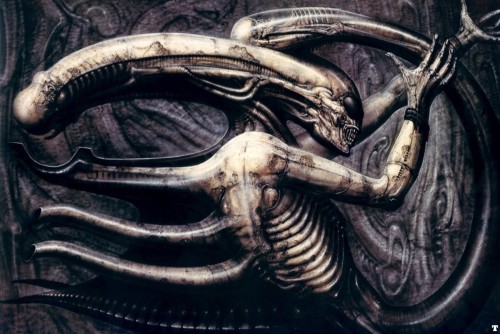
Giger recalled: “in the beginning we had no idea what the Alien should look like. In most horror movies, the Monster looks very unbelievable and sometimes ridiculous – and once you see it, the film is over because it looks just like a man in a suit. Ridley Scott and I didn’t want this. We wanted a very unusual Monster — a believable one — and Ridley planned to show it only in little bits, detail by detail so it wouldn’t be given away from the beginning.” Initially, the filmmakers considered portraying the Alien through complex special effect techniques such as stop-motion and elaborate animatronics — but neither budget nor production time allowed such methods to be employed.
It was decided to create the Alien as a suit worn by a performer. Scott initially wanted a feminine creature that would actually be played by a woman. “I remember one of the tallest models,” Powell said, “and quite a well-known model of the time, was this woman called Verushka; she came in, and well literally there she was in a little pair of knickers and we asked her to crouch down — Ridley had this idea that it would be like a sort of praying mantis, and the way when you crouch down, the knees are impossibly high like a grasshopper.” The production crew was unable to find a tall enough woman, and the concept was ultimately dropped. Scott also briefly considered creative variations on the standard creature suits — including using multiple contortionists in a single costume. “I had a guy come into my office,” he recalled, “who ran around on his hands with his head tucked in and his feet stuck out. He looked like some strange sort of crab. He ran all over the top of my desk, and then hopped off on his hands and scuttled across the floor. It was amazing, but he was limited in what he could do. I even brought in a whole family of contortionists with the idea of taking an adult contortionist and then somehow carefully strapping two very small children, who were also contortionists, onto him in various ways. You can imagine if you did that, and then covered them all with some sort of a suit, you’d get a very strange-looking object. It could really scare the shit out of you coming down a corridor.”
“Finally, we decided to make a very elegant creature,” Giger explained, “quick and like an insect. Ridley Scott had an old photo of Leni Riefenstahl with a very tall Nubian; and he was impressed with that, so we decided to make a suit for a tall, very thin man. Ridley still loved the Necronom in my book and wanted something like it, which was nice for me because I could use my own designs and had not to put some body’s else’s work into my own style.” Ultimately hired as the performer inside the Alien suit was Bolaji Badejo, a Nigerian art student. Scott told Cinefantastique Online: “we started with a stunt man who was quite thin, but in the rubber suit he looked like the Michelin Man. So my casting director said, ‘I’ve seen a guy in a pub in Soho, who is about seven feet tall, has a tiny head and a tiny skinny body.’ So he brought Bolaji Bodejo to the office. I said, ‘Do you want to be in movies?’ and he said, ‘sure.’ And he became the Alien.” Bolaji prepared for the role with mime classes. He was not, however, the only suit actor chosen for the film: Eddie Powell portrayed the Alien in the scenes of Brett’s death and Dallas’ abduction, and Roy Scammell played the climax sequence where the Alien is ejected from the Narcissus.

A life cast of Badejo was used as the starting point for the Alien maquette that would be the base for the suits. Initially, Dicken was assigned to the construction of the adult Alien, and tried to reproduce most faithfully the appearance of Necronom IV — which resulted in practical complications. “I set the [cast] up in my lounge and spent a few days building up muscles and tissues on it in clay,” Dicken said. “I even did a wire mesh and cardboard mockup of the head — which looked ridiculous, because in order to maintain the scale from Giger’s picture, the head had to be almost six feet long. It was just much, much too big to mount on a human form.” Giger was disheartened by the results, saying that “When I got to England, I saw the version of my large Alien and it looked terrible — like a dinosaur from Disneyland. I was very depressed because I don’t like to do a nice design and then have it turned into something awful.”

Due to Giger’s disapproval of the designs, Dicken’s first — and ultimately only — attempts were rejected. As a result, he sent a letter to the producers, explaining that he could not — and would not — build the Alien. ”I’d already had enough hassles with the Chestburster and the Facehugger to know that I just wasn’t going to be able to come up with something workable in the amount of time I had left. So I ended up writing a letter to the production office and telling them that they’d better get somebody else to do the big one. Pandemonium set in, and they said I was letting the picture down. But I just told them I wasn’t going to give myself a nervous breakdown trying to create this damned thing in the time required and under those circumstances. If I’d been left to my own devices, perhaps — but not with all the continual changes and setbacks I’d come to expect after nearly three months of sweating blood over the smaller ones.”
Convinced that no one but him could really translate his Alien concept into a three-dimensional character, Giger took the task upon himself — not without difficulties. He recalled: “sculpting something is much more difficult than painting because it has to look good from every angle. It’s even more difficult if the object has to move. My style of painting is a combination of art nouveau and technical stuff. I call it biomechanics — kind of a surrealistic mixture of biology and technology — and I wanted the Alien to have those same qualities.”

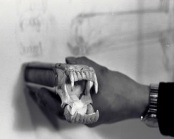
Scott defined Giger’s Alien concepts as “like a rather beautiful humanoid biomechanical insect.” Inherited from Necronom IV was the Alien’s elongated head, a trait that also inspired the inclusion of an inner jaw. “I liked very much the long head,” he explained, “but I kept thinking that a head this long needs to have a certain function. So I gave him a very long tongue, also with teeth — so there are tongue teeth and mouth teeth. I think it’s very impressive in the film to see the lips open and then the jaws, and then you see the tongue come out with its teeth — an escalation of movement.” The design of the tongue itself was based on Giger’s own concept of the Chestburster.
Both the inner and outer jaws displayed human-like, metallic teeth. Giger told Cinefantastique: “those teeth are also in polyester. They were chrome-plated, so as to give them a metallic shine. I imagined them that was because for me the Monster is both human and mechanical — more human than mechanical, though. So giving him steel teeth was a way to convey this two-fold nature.”
One of the major changes applied to the design was the removal of the bulbous black eyes that were prominent in Giger’s early concepts. “In the first design for the Alien,” the Swiss artist said, “he had big black eyes. But somebody said he looked too much like a… what do you call it… a Hell’s Angel; all in black with the black goggles. And then I thought: It would be even more frightening if there are no eyes! We made him blind! Then when the camera comes close, you see only the holes of the skull. Now that’s really frightening. Because, you see, even without eyes he always knows exactly where his victims are, and he attacks directly, suddenly, unerringly. Like a striking snake.” As such, the eyes were replaced with a “translucent shell that covered the top of its head.” Also included in the final design were traits to make the appearance of the Alien stray from a basic humanoid form; those included the four back pipes and the “head rest” protrusion — also conceived to better balance the suit’s elongated head. Originally, O’Bannon wanted the pipes to grow out of the chest, but Scott ultimately chose to make them protrude on the back — much like in Necronom IV. The Alien’s tail was implemented to add more movement and life to the creature. Following a suggestion from O’Bannon himself, the Monster was also given two opposable thumbs on each hand.

Aided by two assistants, Giger sculpted the Alien starting from Badejo’s cast. “I started out with kind of a statue of Bolaji, and directly over that I modeled the shape of the Alien in plasticine,” Giger said, “with bones and tubes and lots of mechanical things. The head I built up from a real human skull using plasticine and flexible piping and stuff.” The sculpture of the head included a real human skull, in line with the concept of inheritance of traits from the Alien’s host. Also included among other details were real Snake ribs (for the Alien’s sternum and tail), real metallic pipes and portions of the engine of a Rolls Royce, and painted bottle caps. “Giger did this black cockroach from hell,” recalled Cobb. “When you saw the suit standing in this little bay where Giger was sculpting it, you would actually flinch when you walked in the room. It was really terrifying.”
The Alien suit was initially intended to be translucent, in a manner that would closely imitate Giger’s own painting style. “I agreed with Scott to make the Aliens translucent,” Giger said. “One should be able to see the skeleton, the blood circulatory system, the organs.” The Alien sculpture was thus cast in hot melt vinyl multiple times, but the material was not as resistant as the sequences required; ultimately, the idea was discarded, also due to a lack of time in the production schedule.

 Italian Maestro Carlo Rambaldi was assigned the task of building an animatronic Alien head that would be used for close-ups of the creature. The artist would remain in England — where production was being held — for a number of weeks, before returning to his work on other film projects — and leaving one of his assistants Carlo De Marchis at helm. Based on the scripts and Giger’s artwork, Rambaldi elaborated an initial idea of the needed mechanisms. He said: “I figured the head would require seven different movements, so I proposed a series of mechanical joints and muscles activated by flexible cables. The front portion needed to pivot up and down and side to side, independent of the rest of the head. I wanted the lips to curl back; and of course, the mouth had to open and close. Inside, the tongue needed to move out and back, and its teeth had to open and close. And I also thought there ought to be a pulsating jugular movement at the throat.” Initially, Rambaldi wanted to build the entire suit — but due to a lack of time, it was decided that he would only build the animatronic head — with the rest of the suit built in the studio by a crew led by Eddie Butler.
Italian Maestro Carlo Rambaldi was assigned the task of building an animatronic Alien head that would be used for close-ups of the creature. The artist would remain in England — where production was being held — for a number of weeks, before returning to his work on other film projects — and leaving one of his assistants Carlo De Marchis at helm. Based on the scripts and Giger’s artwork, Rambaldi elaborated an initial idea of the needed mechanisms. He said: “I figured the head would require seven different movements, so I proposed a series of mechanical joints and muscles activated by flexible cables. The front portion needed to pivot up and down and side to side, independent of the rest of the head. I wanted the lips to curl back; and of course, the mouth had to open and close. Inside, the tongue needed to move out and back, and its teeth had to open and close. And I also thought there ought to be a pulsating jugular movement at the throat.” Initially, Rambaldi wanted to build the entire suit — but due to a lack of time, it was decided that he would only build the animatronic head — with the rest of the suit built in the studio by a crew led by Eddie Butler.

Rambaldi was sent a fiberglass cast of the Alien’s head as a starting point and elaborated from there how the mechanisms of the animatronic should be included. “Since an actor had to wear the head it was very important to make it as lightweight as possible,” Rambaldi elaborated. “I used fiberglass for the skull and moving parts, and aluminum inside for support. The tongue, for example, was fiberglass mounted on geared metal tracks and could extend about twenty centimeters – either very slowly or very fast. Each moving part was connected to a special sheathed cable- like hand brakes on a bicycle, only more flexible – which ran out through a hole in the base of the head. Normally, each moving part would require only a single cable, but the sideways movement of the head and the mechanism for the tongue required two opposing cables — kind of like reins on a horse. So there were nine all together. The cables were seven meters long and connected to hand-operated levers mounted on a wooden panel. By operating the levers in various combinations, a great many moves were possible.”
The fiberglass understructure of the Alien head was covered with polyurethane, cast by Ralph Cobos (one of Rambaldi’s assistants) from a plaster mould. The material employed a particular formula that had been perfected by Rambaldi himself — allowing it to be a quarter of an inch thick, and at the same time resistant and life-like. Cobos elaborated: regular polyurethane has two components — a base and a catalyst. Ours has seven. For some applications we might need more strength; for others we might want more elasticity. Since each additive controls a different variable, we can alter the characteristics of the polyurethane by varying its components. One of the things that makes Carlo’s figures so unique is that his polyurethane has a nice skin on it when it comes out of the mold. It wrinkles like real skin and stretches like real skin. Regular polyurethane doesn’t have a skin at all — it’s just kind of spongy.”
Rambaldi and his crew built a total of three heads, and brought them to London. Two were fully articulated hero heads (one for back-up) whereas the third was a stunt head with only articulated lips. Upon arrival, the animatronic head had to be modified: the mechanisms functioned, but it needed an artistic revision. The independent movements of the front portion of the head were removed, and the face itself was tweaked; Giger initially found that “it resembled an ape” — an impression derived from minor alterations, made strictly to arrange the mechanisms inside the head. The animatronics were painted by Giger himself. Finishing touches included the replacement of the lips with transparent rubber, and the addition of chrome-plated teeth. The muscles and tendons of the Alien’s jaw were “made out of stretched and shredded latex contraceptives,” and the dome was cast in translucent vacuform plastic. The production crew also built three stunt Alien heads for long, elaborate shots of the creature that did not require close-ups.
David Watling was also concurrently assigned the task of creating an animatronic Alien head (in case Rambaldi’s did not function properly) and an animatronic tail; both models, which were radio-controlled, did not fit the requirements for the sequences they had to be shot in. The tail was lackluster and was immediately discarded. It was replaced with a simple tail model, puppeteered with wires. Regarding Watling’s Alien head, it was actually outclassed by Rambaldi’s — which was used throughout the film, in close-ups. “There was no call to use [Watling’s version]. Most of the Alien shooting was finally done pretty close up, and, therefore, the cable system of Rambaldi’s was much more practical. Remote control just isn’t as subtle as a hand-operated mechanism.” Scott was extremely impressed with the results: “normally you can’t stand to have the camera take a close look at things like this,” he said, “but it was so good I just did a huge close-up on it.” Rambaldi himself was satisfied with his work, but would have liked more focus on it in the film. “They use all the movements,” he said, “but the head cuts are so quick, and the action is framed so predominantly in extreme close-up, that frequently it’s impossible to tell what you are seeing! In my opinion, I gave the director 100 possibilities, and he used but 20.”
Rambaldi’s animatronic heads worked “wonderfully,” according to Giger, but needed to be combined with the proper amount of KY Jelly. “The cables coming out of the head were a bit of a problem,” Johnson said. “We had to dress those so you couldn’t see them and at the same time allow the maximum amount of flexibility. Also, we found that you could see the mechanism which operated the head. So that’s when the goo appeared — the goo covered up the mechanism. We rubbed the whole head with KY jelly and also had it oozing out of the mouth. We must have used gallons of that stuff, because it drips off slowly and you’re constantly replacing it.” As a result of the considerable use of KY Jelly, the paint scheme was constantly washed out of the creature; Giger had to repaint the Alien after each day of shooting.
The suits themselves presented some practical issues. The skin was mostly moulded in foam latex, and painted by Giger himself with an airbrush. The initial costume design was too rigid for a proper performance. “The first costume was so cumbersome that the actor couldn’t do a great deal of movement in it,” Johnson recalled, “and though Ridley never intended to be so explicit with the Alien that you could stare at it for minutes at a time and see everything, he did want it to be fairly flexible. He wanted the creature to be able to roll up in a ball and that sort of thing. Well, they couldn’t do any of that in the beginning — the costume was just too rigid — so there had to be considerable modifications.”

Butler ultimately devised three suits that would be assembled from a dozen separate components, and could be used each for different camera angles. Another suit was also built for Powell and Scammell. Though improved, the suits still did not allow the intended freedom of movement for the performer. O’Bannon told Fantastic Films: “unfortunately, the real grace was lost, because the suit proved to be very awkward to move in. The actor wasn’t able to make many moves in a graceful manner. Ridley was forced to stage around the physical awkwardness of it. But the visual appearance of power and grace was retained — quite striking.”
At one stage during filming, Scott wanted to add another layer of animation to the creature — by inserting a pocket filled with maggots inside the Alien’s head, simulating a writhing brain. “I wanted to have a kind of subtle movement in the creature’s brain,” he said, “so I thought maybe we could fill a pocket in the cranium with white maggots and let them crawl around in there. Even Giger went ‘eeyuk!’ at that one. But I decided to try it, so I had these huge tins of maggots brought in. We couldn’t make it work, though, because the heat from the lights would put the bloody things to sleep and they’d just lie there like spaghetti. We tried using Spanish fish, which look kind of like wireworms, but they went to sleep too.” Scott ultimately had to discard the idea.
 Perhaps the most important among the discarded concepts was the so-called ‘Eggmorphing’ process, shown in a scene towards the end of the film — where Ripley finds Brett and Dallas, cocooned and slowly transforming into eggs. “I liked it because it was a brief way of explaining what had happened on the derelict, and what was now happening on the Nostromo,” Scott said. Dallas pleads Ripley to kill him, and she burns the nest down. Giger designed and built a wall set and cocoons (which he and Scott found in retrospective underwhelming) for the scene, which was filmed and initially part of the finished film. Tom Skerritt was (of course) replaced with a dummy in the sequence where Ripley burns the nest. Ultimately, Scott found that “it really killed the pacing,” and the scene was cut from the final film.
Perhaps the most important among the discarded concepts was the so-called ‘Eggmorphing’ process, shown in a scene towards the end of the film — where Ripley finds Brett and Dallas, cocooned and slowly transforming into eggs. “I liked it because it was a brief way of explaining what had happened on the derelict, and what was now happening on the Nostromo,” Scott said. Dallas pleads Ripley to kill him, and she burns the nest down. Giger designed and built a wall set and cocoons (which he and Scott found in retrospective underwhelming) for the scene, which was filmed and initially part of the finished film. Tom Skerritt was (of course) replaced with a dummy in the sequence where Ripley burns the nest. Ultimately, Scott found that “it really killed the pacing,” and the scene was cut from the final film.
Filming the Alien proved to be complex. Hours of footage were shot, but were found to be underwhelming — and most of the times the actors could not perform the quick, agile and insect-like movements that Scott wanted. Production designer Michael Seymour said: “the Alien was an immensely elaborate and detailed piece of work, but we had to be very careful about how we shot it; and we had countless discussions about that, because in the end, if you held on it for more than a few seconds, it became just another man in a rubber Monster suit — and of course, that was unacceptable.” Allder further elaborated: “we were really quite limited with what we could do with the Alien. At one point, the script called for it to run up and down the corridors like a human being; but when we finally got the finished costume, we stayed late one night — at the end of a day’s shooting — just to see what it looked like in the sets and to shoot a few tests; and of course, we found it would look ridiculous to see this thing running around — it would give the whole thing away immediately.”
The suit was used in combination with a number of other stage effects; in the sequence of Brett’s death, the performer in the suit was suspended with a harness; most of the time, however, it was a restraint. Many sequences were heavily modified when compared to their original version; one example is Dallas’ abduction, as explained by Scott: “what I wanted was to have really huge air ducts — taller, in fact, than the corridors in the ship — so that when Dallas first sees it in there, it’s standing on the roof of this giant wind tunnel suspended upside down. Then I was going to have it roar down the tunnel toward him, running and jumping full-circle around the walls.” This concept was too impractical to achieve and was abandoned, in favor of the final version — where Dallas is abducted in a claustrophobic air duct.
In the film’s finale, Ripley escapes the destruction of the Nostromo aboard the Narcissus. What she does not know at first is that the Alien has actually hidden among the machinery. “Originally, we thought the Alien would be hiding in the closet in the lifeboat,” Shusett told Cinefantastique Online. “But then Ridley said, ‘can’t we beat that? Can’t it be somewhere [Ripley] and the audience can’t see it and it just emerges?’ So at the end of shooting every day, we changed the set around the Monster. He’d lay in there and we’d rebuild the set over and over. Every time, it looked like Mad magazine – you could see [the creature] was two feet away from her! The guy who played the Monster would lay there for hours and hours and we’d shoot it and look at it the next day and say, ‘this is stupid; we’ll never disguise it.’ The trick that really made it work was the [shape of the Alien’s] head. Finally, somebody got the idea: we’ll put an air vent that looks like its head above and below it, so when the hand comes out, it’s not coming from behind anywhere — he’s in the wall. We had just built that. We didn’t know if it worked. So Ridley said, ‘Let’s get the guy back in here.’ We yelled for him — and he was in the wall! We were shot with our own arrow — we jumped a mile! So we filmed it, and it worked perfectly.”
A dropped concept was a short life span of the Alien, in correlation with the excision of the eggmorphing scene. Scott elaborated in an interview with Fantastic Films: “I wanted a sense of a timeless, slightly decaying creature that, maybe, only has a limited life cycle of, maybe, four days like an insect.” In Alien: The Special Effects, he added: “I think it provided some explanation for the Alien’s killing spree — like a butterfly or an insect, it has a limited lifespan in which to reproduce itself. It also helped explain why it didn’t attack Ripley in the Narcissus; its days were over. Like a chameleon, it had found a protective corner in that ship and was working itself in there to die.” Scott also hinted at an alternative idea — following which the Alien could metamorphose back to an egg, in a manner similar to how the Immortal Jellyfish is able to revert its growth pattern and return to its polyp stage. Scott told L’Ecran Fantastique: “I wanted the Alien to continually change shape. When it appears in the machinery at the end, it could very well be dying, finishing there its very limited life cycle — maybe even metamorphosing into a chrysalis, so that its physical volume decreases in order to return in the form of an egg and hibernate again.”
Originally, the storyboarded ending involved Ripley and the Alien getting ejected out of the Narcissus, with the former making her way back inside the ship and blasting the creature as it tries to enter one of the engines, disintegrating it once and for all. In the final version, Ripley shoots the creature with a harpoon gun. Scammell, in the Alien suit, was secured to a cord and dropped from the Narcissus set — which had been mounted upside-down — and then pulled up again, to simulate the Alien trying to find a way to enter from the engine (a full body shot the producers insisted upon). The performer was dropped again to portray the free-falling creature hit by the force of the Narcissus’ engines (lack of time and budget did not allow to convey the creature’s disintegration. The Alien is ultimately blasted away into space.
Giger ultimately commented on the experience and the creature: “I have worked on enough films now to realize that nothing may quite satisfy me the way the original Alien film collaboration did. There, I was given the freedom to do everything myself, from the design to the actual physical sculpting. I made myself a prisoner on that film and, in fact, that is what is necessary to allow for the fulfillment of the successful evolutionary process known as creature development and design.”
O’Bannon praised the Alien, saying that “I truly believe that that Monster in Alien is absolutely unique looking. I think that it is two strides beyond any Monster costume in any movie ever before; and some of them are goodies, like The Creature from the Black Lagoon, or This Island Earth — the bug with the exposed brain — some of those were terrific. I really think this is a step beyond. I don’t think that anybody’s seen anything like this.”
For more images of the Alien, visit the Monster Gallery.
Previous: Alien, the Chestburster
Next: Aliens

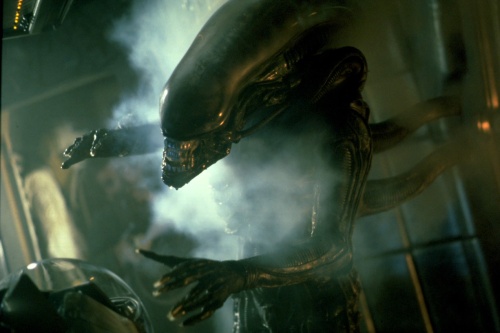
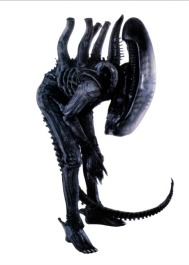






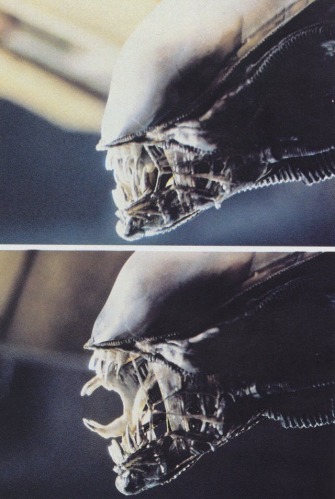


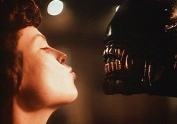



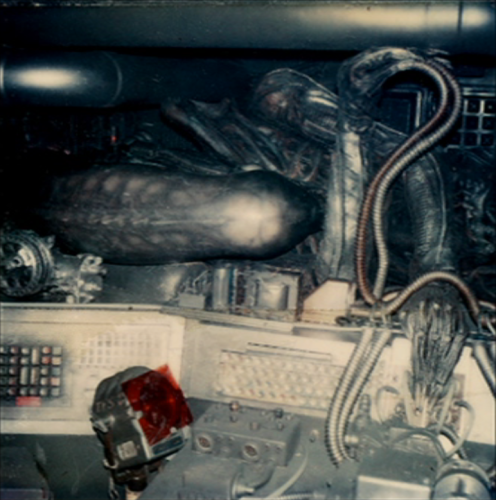

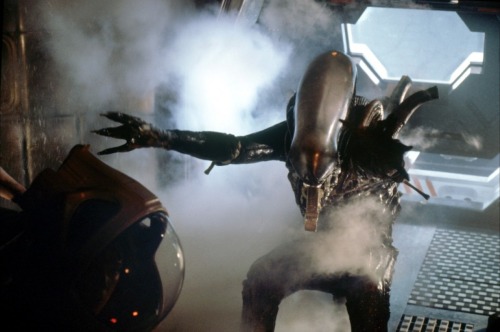


Quanto vorrei rivedere un Alien con questo stesso identico design in film futuro.
Per me la versione traslucida avrebbe potuto funzionare se ci fossero stati i mezzi per metterla in pratica: sarebbe apparso come uno spettro nei meandri della Nostromo…..
Il concetto di una creatura traslucida è stato ben realizzato per SPECIES e SPECIES II (a cui Giger ha collaborato). Con la tecnologia di oggi il costume dell’Alien verrebbe realizzato in modo eccellente.
On the tall model, Verushka…
http://www.thefashionspot.com/runway-news/20309-veruschka-model-profile/
Third picture in your link — very Alien-like pose! Wonder how different the performance could have been.
First, and still the best.